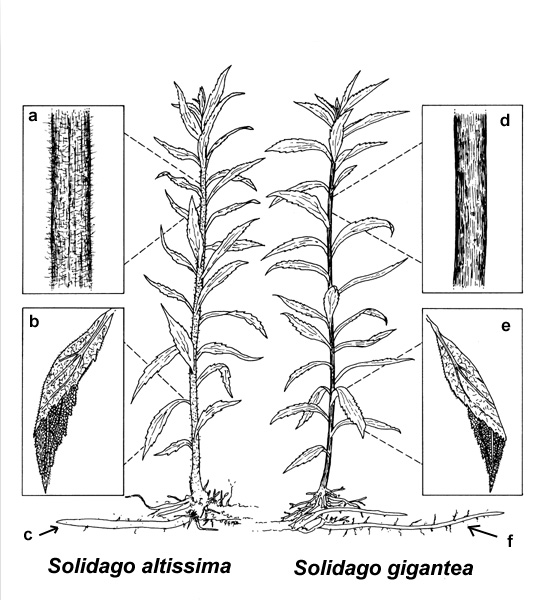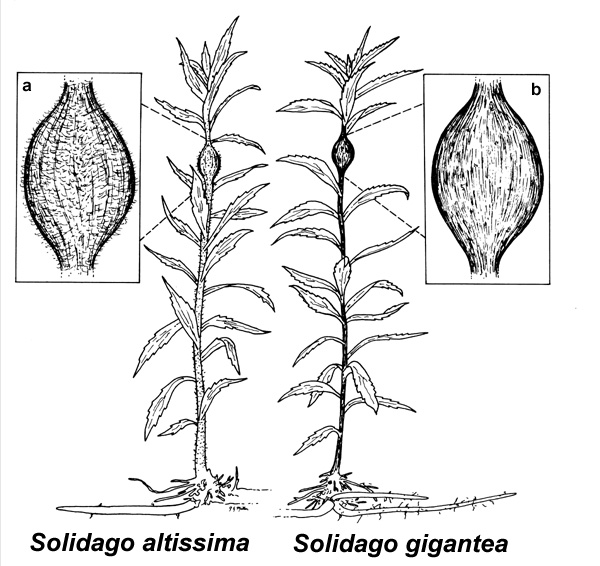Identification of the Solidago Species
Some Notes on Recognition of the Members of the Solidago canadensis
Polyploid Complex in Central Pennsylvania
| Solidago gigantea (tetraploid & diploid) | Solidago canadensis (typically diploid) | Solidago altissima (typically hexaploid) | |
| Habitat | Wet spots in open fields, meadows, ditches. Occasionally under shade of deciduous woods. | Generally found in open areas, but avoids the dry portions of fields, where S. altissima tends to predominate. |
Most cosmopolitan of the three species in habitat preference, can grow side-by-side with other two but usually found by itself in well-drained habitats (hillsides, road banks). |
| Stem | Glabrous (smooth) from ground level up to the inflorescence. Often with a waxy whitish bloom that gives the stem a pale blue or purple cast. Distinctive. | Has villous (woolly, long-haired) pubescence from inflorescence most of the way to the ground, often tapering off sharply on the bottom few inches. | Entire stem is pubescent (hairy), usually with very short, almost granular-gritty hairs. Some forms show a long, woolly pubescence similar to S. canadensis. Separate using leaf characteristics. |
| Leaves | Very sharply serrate (with small toothed edge), always totally glabrous above. Usually smooth below, although some plants show pubescence on major leaf veins. | Sharply serrate to dentate (deeply cut, sawtooth teeth), smooth or slightly scabrous (course) above, with pubescence on underside but confined almost entirely to the three major leaf veins. Leaves can be very broad on some plants. |
Shallowly serrate to subentire (almost no teeth); almost always smoother edged than leaves of S. canadensis, but highly variable. Usually very scabrous above and with pubescence over entire underside, not just on veins. Leaves tend to be more lanceolate (narrow) than S. canadensis. |
| Flowers | Not needed to identify this distinctive species. Bloom starts in early July-early August. |
Involucral bracts (see figure below) usually 2-3 mm high, ray flowers about 2.5 mm long. Bloom starts in late July.
|
Involucres tend to be large (> 3 mm), as do ray flowers. Inflorescences can sometimes be enormous. Bloom commences later, usually August. |
| Remarks | Easiest species to identify. To the south, it seems to be totally free of ball galls, but is a common host to the elliptical gall and occasional rosettes galls. In northern areas, such as New England and the upper Midwest, ball galls are common. Not rare, but never as plentiful as S. altissima. | Like S. gigantea, seems to be free from all but the occasional ball gall. Often tricky to separate from S. altissima. This species often looks darker green than S. altissima. Not common, doesn’t seem to occur in huge unbroken clones like S. altissima. More common in northern New England. | Any plant in central PA with a ball gall is liable to be this species. Also host to elliptical, rosette, and various leaf galls. Can grow in amazingly barren ground, e.g., railroad embankments. Abundant. |

Figure 1: Comparison of Solidago altissima vs. Solidago gigantea mature plants

Figure 2: Comparison of galls of Solidago altissima vs. Solidago gigantea
